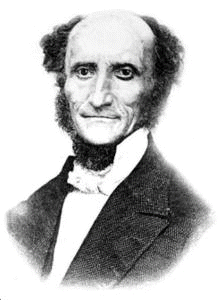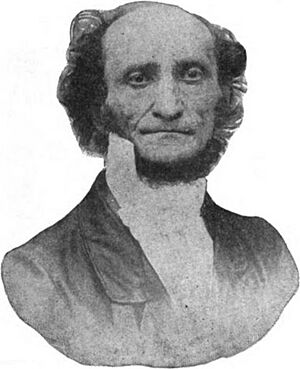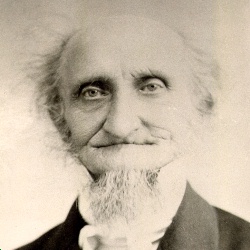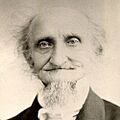C. F. W. Walther facts for kids
Quick facts for kids C. F. W. Walther |
|
 |
|
| Born | October 25, 1811 in Langenchursdorf, Kingdom of Saxony |
|---|---|
| Died | May 7, 1887 in St Louis, Missouri, U.S. |
| Church | Lutheran Church–Missouri Synod (LCMS) |
| Education | University of Leipzig |
| Ordained | January 15, 1837 |
| Writings | The Proper Distinction Between Law and Gospel, Church and Ministry, Der Lutheraner (periodical) |
| Congregations served | Trinity Lutheran Church, St Louis, Missouri |
| Offices held | President, LCMS (1847-1850; 1864-1878) President, Concordia Seminary |
| Spouse | Emilie Buenger |
Carl Ferdinand Wilhelm Walther (born October 25, 1811 – died May 7, 1887) was an important German-American Lutheran minister. He became the very first president of the Lutheran Church – Missouri Synod (LCMS). He was also their most influential theologian, which means he was a leading thinker about religious ideas. The LCMS remembers him on their special calendar on May 7. People say he left his home country of Germany to come to the United States so he could speak freely, believe freely, and live freely.
Contents
Early Life and School
C. F. W. Walther was born in Langenchursdorf, a town in what was then the Kingdom of Saxony (now part of Germany). His father was a pastor. Because he felt very strongly about his faith, he moved to the United States in 1838. On September 21, 1841, he married Emilie Buenger, and they had six children together.
Walther started two important publications and wrote many books and articles. He was also the main pastor for four Lutheran churches in St. Louis. In 1877, he received a special Doctor of Theology degree. He passed away in St. Louis on May 7, 1887. He was buried in Concordia Cemetery, where a special building was later built to honor him.
Ferdinand, as his family called him, first learned from his father. When he was eight, he went to school in Hohenstein for two years. After that, he attended a "Latin school" in Schneeberg, which was a school that prepared students for college. He finished there in September 1829.
A month later, he started studying theology at the University of Leipzig. His older brother, Otto Hermann, was already studying there. While in college, Ferdinand got a serious lung disease and had to stop his studies for six months. During his recovery, he read many books by Martin Luther. He became convinced that Luther's ideas truly followed the teachings of the Bible. He also started believing it was important to stick firmly to Lutheran beliefs.
In 1833, Walther took his first university exam. This allowed him to work as a private tutor for a family in Kahla. After two years of tutoring, he took his second exam in Leipzig and graduated. On January 15, 1837, he became a Lutheran pastor in Bräunsdorf, Saxony. He also taught religion classes at the local school. However, he soon disagreed with the government of Saxony. He felt they were moving away from the true faith and teachings of Lutheranism. Many other Lutherans also opposed the government's relaxed religious rules.
Walther's Career
Leaving Saxony
Walther and many other Lutherans who disagreed with the government joined a pastor named Martin Stephan from Dresden. In November 1838, about 800 Saxon immigrants, led by Stephan, left Germany on five ships for America. This journey is known as the Saxon Lutheran Migration. They hoped to find freedom to practice their religious beliefs. The settlers arrived in New Orleans on January 5, 1839. The group settled in St. Louis, Missouri and also in Perry County, Missouri, along the Mississippi River.
The Altenburg Debate
After some problems with their leader, Martin Stephan, the immigrants felt confused. They wondered if they were still a true Lutheran church, since they had left the church leaders in Germany. Walther was serving as a pastor in Perry County. He also struggled with these questions, just like the other people and pastors.
In April 1841, a public discussion happened between Walther and a lawyer named Marbach. This event is called the "Altenburg Debate." Walther was able to convince Marbach and most of the other settlers that they were indeed a valid church. After this, Walther accepted a call to be the pastor of Trinity Lutheran Church in St. Louis, where his brother had been pastor. He served there from May 1841 until he died.
Walther's Ministry
During his forty years of work, Walther held several important jobs in the LCMS. He helped start a log cabin college in December 1839 in Altenburg. This college later grew into Concordia Seminary in St. Louis. Walther became its first president and stayed in that role for the rest of his life.
On April 26, 1847, the Lutheran Church – Missouri Synod was officially started. Walther was its first president from 1847 to 1850, and again from 1864 to 1878. He also became president of another seminary in 1861.
He also started and edited several Lutheran magazines, like Der Lutheraner and Lehre und Wehre. He wrote many theology books. His most famous book is probably The Proper Distinction Between Law and Gospel. This book came from a series of evening talks he gave at the seminary. He also wrote the words and music for the hymn "He's Risen, He's Risen."
Walther strongly disagreed with the ideas of other religious groups in America and the influence of non-religious ideas on Lutheran beliefs. He worked hard to protect the teachings and culture of the Lutheran Church.
Walther's Home
Walther Film
In 2011, to celebrate 200 years since Walther's birth, Concordia Seminary in St. Louis, Missouri made a video series called "Walther." It showed his life and the history of the Lutheran Church – Missouri Synod. Concordia Seminary shared these videos with LCMS churches in October 2011. There were also study guides and Bible study materials to go with each video.
Images for kids








